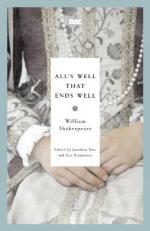|
This section contains 21,100 words (approx. 71 pages at 300 words per page) |

|
SOURCE: “All's Well That Ends Well,” in Gender and Performance in Shakespeare's Problem Comedies, Indiana University Press, 1997, pp. 37-78.
In the following essay, McCandless focuses on the evolving gender roles of Helena and Bertram in All's Well That Ends Well, discussing Shakespeare's handling of the bed trick as a tool for exploring gender myths.
The starting point for my discussion is Susan Snyder's recent characterization of All's Well as a “deconstructed fairy tale”:1 lurking beneath the folkloric narrative of the poor physician's daughter who deploys magic and cunning in order to overcome a dashing Count's disdainful resistance are the unrepresentable spectres of female sexual desire and male sexual dread. Indeed, the play invests the fairy tale motifs that W. W. Lawrence believes undergird All's Well—“The Healing of the King” and “The Fulfillment of the Tasks”—with potent erotic subtexts.2 In adapting “The Healing of the King,” Shakespeare...
|
This section contains 21,100 words (approx. 71 pages at 300 words per page) |

|


